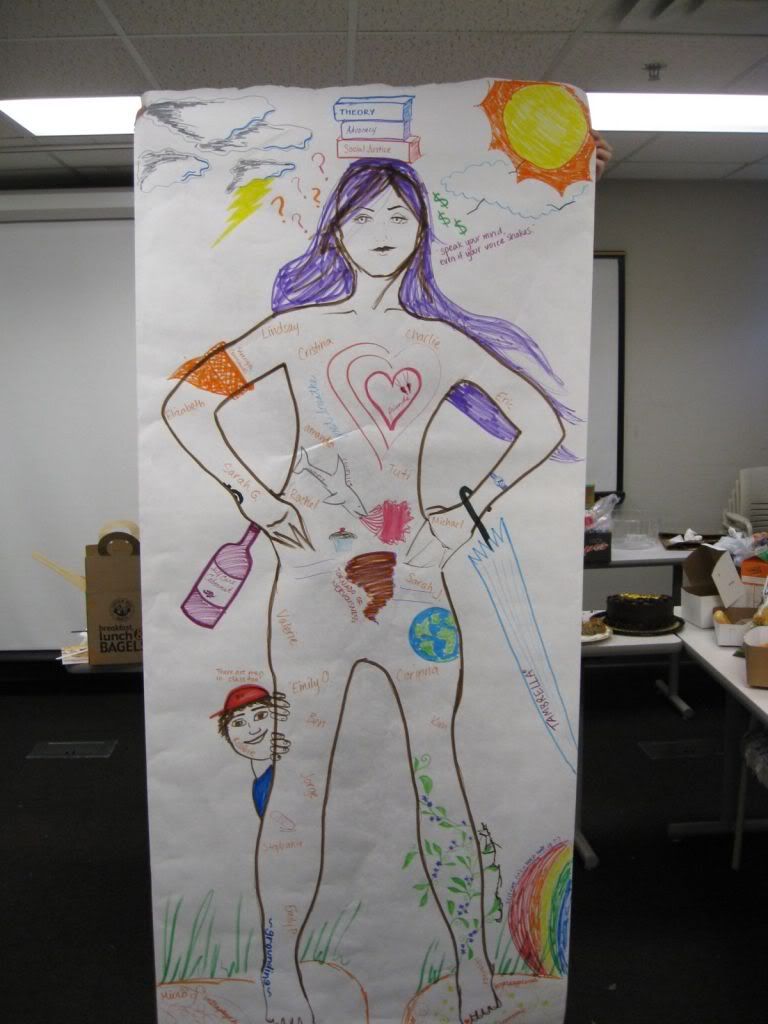 Photo: A body outline drawing of Valerie in which each piece of the drawing represents Valerie’s journey through the Social Work program.
Photo: A body outline drawing of Valerie in which each piece of the drawing represents Valerie’s journey through the Social Work program.
For those of you KbloG readers who don’t already know, I started working on my Master’s in Social Work last fall. It’s hard for me to believe that I only have NINE weeks of class left before I finish my last “real” courses and begin my final internship before my May 2012 graduation. Of course, as you know because you’re reading this blog post, I couldn’t bear to leave the awesome Ketner Group team so soon, so we’ve worked together to make it possible for me to “lead a double life” and do both. Even though there are few weeks in there that I’ve all but forgotten due to lack of sleep, I wouldn’t have changed a thing (short of altering the laws of time in which the day is 30 hours long – the parents are all nodding their heads in agreement!)
I could go on for way too long about the experiences I’ve had, but for the purposes of this post, I thought it would be fun to talk about a few of the things I’ve picked up in social work that I could see the PR world benefiting from. If I really sat down and thought about it for a while, it would be a LONG list – but as you can imagine, I’ve got studying to do, so let’s make it snappy!
“Yes…. and….” – My beloved first-year practice instructor, Tammy, drilled this one into us on day one, and we all thought it was kind of silly, but now, I try to drill it into anyone I catch making a “yes…., but” statement. We’re humans. We love to think we’re right, and we love to argue. But it can get pretty obnoxious when you’re talking with someone and they keep pretending to agree with you at first, then negating exactly what you said with their “Yeah that’s true but I mean….” statements. Being on the receiving end of these comments is no fun, and it happens more than we realize – oh, until now, because you’ll start realizing it all the time. So what’s the alternative? The more positive and respectful “yes, AND” statement. What I didn’t know until I Googled this just now is that it’s also an improv comedy technique, which makes total sense! No one wants to watch an improv skit where the comedians can’t let go of their preconceived ideas or egos rather than playing off what’s going on in the moment. Continue reading →


 Let’s face it, there are some days where we just don’t want to get up and go to work – you are lying if you say otherwise. Other than those few days a year, I will say that I genuinely enjoy coming to work at our funky little offices. Why? I love the people that I work with! We are like a family here. We look out for each other, and support each other at and outside the office. In fact, compared with the company culture at other small businesses (and corporate organizations) we almost live in a protective bubble.
Let’s face it, there are some days where we just don’t want to get up and go to work – you are lying if you say otherwise. Other than those few days a year, I will say that I genuinely enjoy coming to work at our funky little offices. Why? I love the people that I work with! We are like a family here. We look out for each other, and support each other at and outside the office. In fact, compared with the company culture at other small businesses (and corporate organizations) we almost live in a protective bubble. Daily agency life often feels like an elaborate juggling act—account managers constantly juggle accounts and each account’s unique priorities and deadlines. This requires switching gears throughout the day, usually several times an hour. The necessity of this workflow is obvious—we need to be available to our clients throughout the day as projects and issues pop up, and we strive to efficiently handle projects as if each account were our only account. The KG team prides ourselves on being flexible and in our ability to nimbly manage dozens of loose ends at a time. However, it would not be a stretch to call this style of work ‘multi-tasking,’ and from
Daily agency life often feels like an elaborate juggling act—account managers constantly juggle accounts and each account’s unique priorities and deadlines. This requires switching gears throughout the day, usually several times an hour. The necessity of this workflow is obvious—we need to be available to our clients throughout the day as projects and issues pop up, and we strive to efficiently handle projects as if each account were our only account. The KG team prides ourselves on being flexible and in our ability to nimbly manage dozens of loose ends at a time. However, it would not be a stretch to call this style of work ‘multi-tasking,’ and from  comparing what I thought a career in PR would look like at 21 to what it actually is after nearly 5 years of going from internships to account coordinator and executive roles to senior account manager. Now I love my job and I’m sure I chose the best career for me, but one thing is certain: At 21, I had not even a clue what I was in for.
comparing what I thought a career in PR would look like at 21 to what it actually is after nearly 5 years of going from internships to account coordinator and executive roles to senior account manager. Now I love my job and I’m sure I chose the best career for me, but one thing is certain: At 21, I had not even a clue what I was in for. Photo: A body outline drawing of Valerie in which each piece of the drawing represents Valerie’s journey through the Social Work program.
Photo: A body outline drawing of Valerie in which each piece of the drawing represents Valerie’s journey through the Social Work program. 